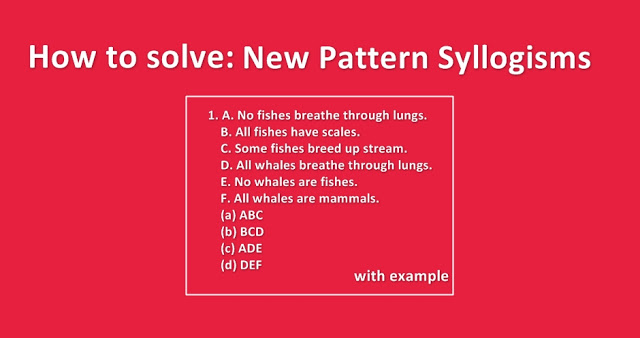Hello and welcome to exampundit. Here is an awesome article on How to Solve new pattern Syllogisms for SBI & IBPS PO Exam. This article is written by EP’s own, Sourav!
Choose the options that indicates a combination where the third statement can be logically deduced from the first two statements and that option will be your answer.
1.
A. No fishes breathe through lungs.
B. All fishes have scales.
C. Some fishes breed up stream.
D. All whales breathe through lungs.
E. No whales are fishes.
F. All whales are mammals.
(a)
ABC
(b) BCD
(c) ADE
(d) DEF
RULE: In these questions, you are asked to test the validity of syllogism…. Check from the options only…..In options, if from 1st statement & 2nd statement, you get the 3rd statement…. Then the respective option is the answer…. i.e. you just need to check the set in which the 3rd statement is a logical conclusion of the first two.
(in first option) statement A suggests no F breathe through L. Next statement B gives all F have S Statement C suggests some F breed up ST (stream). But here statement C is not the logical conclusion of the first two. The diagram would look like this-
In second option also, “all F have S” & “some F breed up ST” do not conclude “all W breathe through L” .Clearly no need to draw any diagram because W & L are not present in its parent statements.
Here the 3rd option is the answer because statement E ( no W are F) is the correct conclusion of statement A (no F breathe through L) & statement D (all W breathe through L)
2. A. Some of my closest friends disapprove of me.
B. Some of my closest friends are aardvarks.
C. All of my closest friends disapprove of me.
D. All who disapprove of me are aardvarks.
E. Some who disapprove of me are aardvarks.
F. Some of my closest friends are no aardvarks.
(a) BCD
(b) ABD
(c) BCE
(d) ABE
Check (in 1st option) if from statement B & statement C we get the Statement D (some CF are A, all CF are D—- does it imply All D are A ??? ) but here All D are not A. The Venn diagram would look like this-
3. A. All roses are fragrant.
B. All roses are majestic.
C. All roses are plants.
D. All roses need air.
E. All plants need air.
F. All plants need water.
(a) CED
(b) ACB
(c) BDC
(d) CFE
In option 1, all R are P; all P need A , which surely implies all R need A. The diagram would look like this-
Regards
Team ExamPundit
This post was last modified on April 27, 2018 11:34 am




